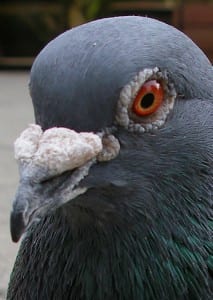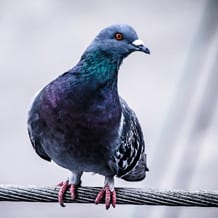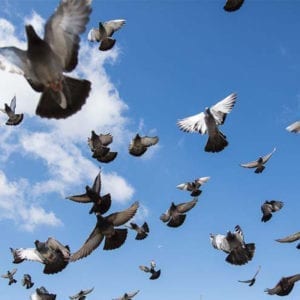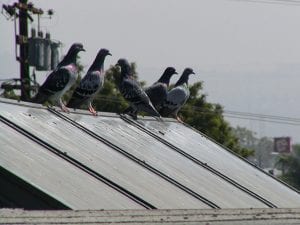
by johnnymarin | Jan 25, 2019 | Pigeon Patrol's Services
 Some children and adult patients with compromised immune systems have been transferred to another area of the hospital away from the source, which the health board said was a “non public area,” and the droppings were removed.
Some children and adult patients with compromised immune systems have been transferred to another area of the hospital away from the source, which the health board said was a “non public area,” and the droppings were removed.
However, a separate issue was then found in the sealant in some of the hospital’s shower room.
Investigations are continuing and air quality tests are being carried out.
The infection is caused by inhaling spores, carried in the air, of the fungus Cryptococcus, which is found in pigeon droppings.
Most infections are mild and produce either no symptoms or a minor influenza- like illness.
However the disease can cause meningitis, high fever, blood abnormalities, pneumonia and even death.
NHS Greater Glasgow and Clyde said control measures were immediately put in place, including the installation of air filters and there has been no other cases.
A spokesman said: “We have found a likely source in a non-public area away from wards and the droppings were removed.
“The small number of paediatric and adult patients who are vulnerable to this infection are receiving medication to prevent potential infection. “This has proved effective.
“As an additional precaution, we have also installed portable HEPA filter units in specific areas. These HEPA machines filter the air continuously to give us reassurance for this vulnerable group of patients.
“During the detailed investigation, a separate issue has arisen with the sealant in some of the shower rooms.
“Repairs are underway and our maintenance team are working to remedy this issue as quickly as possible with the minimum disruption.
“As a further precaution, a specific group of patients are being moved within the hospital due to their clinical diagnosis and ongoing treatment.”
Teresa Inkster, Lead Consultant for Infection Control, said: “Cryptococcus lives in the environment throughout the world. It rarely causes infection in humans.
“People can become infected with it after breathing in the microscopic fungi, although most people who are exposed to it never get sick.
“There have been no further cases since the control measures were put in place.
“In the meantime we are continuing to monitor the air quality and these results are being analysed.
“It remains our priority to ensure a safe environment for patients and staff.”
About Pigeon Patrol:
Pigeon Patrol Products & Services is the leading manufacturer and distributor of bird deterrent (control) products in Canada. Pigeon Patrol products have solved pest bird problems in industrial, commercial, and residential settings since 2000, by using safe and humane bird deterrents with only bird and animal friendly solutions. At Pigeon Patrol, we manufacture and offer a variety of bird deterrents, ranging from Ultra-flex Bird Spikes with UV protection, Bird Netting, 4-S Gel and the best Ultrasonic and audible sound devices on the market today.
Voted Best Canadian wholesaler for Bird Deterrent products four years in a row.
Contact Info: 1- 877– 4– NO-BIRD (www.pigeonpatrol.ca)

by johnnymarin | Jan 24, 2019 | Pigeon Patrol's Services

In a bizarre but sweet incident, Western Railways stopped services for 5-minutes to rescue a pigeon during peak morning rush hour on Wednesday.
A pigeon got caught in a kite thread and was stuck on an Overhead Equipment mast in Mumbai’s Goregaon railway station. One of the passengers saw it and informed the station master. The latter promptly alerted the Fire Brigade and other requisite authorities, Times of India reported.
After that, the OHE’s power supply was halted for five minutes from 10.28 am to 10.33 am and the bird extricated from its trap.
The authorities were aided by Goregaon’s Samkit Group that offers bird protection and rescue services in the city.
Following Makar Sankranti, social media and animal rights activists were embroiled in serious debate regarding the danger sports like kite flying can cause to birds. An image of a parrot hanging dead from ‘noose’ made of a kite string after the kite-flying festival left many shocked and disturbed.
But while the parrot met an unfortunate end, the pigeon fared better and managed to save its life, thanks to Western Railways.
A similar incident occurred last year in September when a train operator in Delhi Metro Rail Corporation’s newly inducted magenta line stopped the train on the tracks to save the life of a bird which had fallen on the tracks.
About Pigeon Patrol:
Pigeon Patrol Products & Services is the leading manufacturer and distributor of bird deterrent (control) products in Canada. Pigeon Patrol products have solved pest bird problems in industrial, commercial, and residential settings since 2000, by using safe and humane bird deterrents with only bird and animal friendly solutions. At Pigeon Patrol, we manufacture and offer a variety of bird deterrents, ranging from Ultra-flex Bird Spikes with UV protection, Bird Netting, 4-S Gel and the best Ultrasonic and audible sound devices on the market today.
Voted Best Canadian wholesaler for Bird Deterrent products four years in a row.
Contact Info: 1- 877– 4– NO-BIRD (www.pigeonpatrol.ca)

by johnnymarin | Jan 22, 2019 | Bird Deterrent Products
 A man has been left devastated after discovering three of his pigeons had been shot dead.
A man has been left devastated after discovering three of his pigeons had been shot dead.
Sean Wardle, of Carlin How, made the grim discovery when he went to the allotments below Mount Pleasant on Tuesday afternoon to feed his birds
He told how he arrived at the site to find three of his Tumbler pigeons were dead after being shot.
The 49-year-old, who visits the allotments every day, says each of the birds had a “slug hole in the back of their neck”.
He said: “I’m devastated really.”
Self-employed Sean, who has had pigeons for over a decade, keeps the birds in a pigeon loft.
However he has had a number of previous issues – this was the second similar incident at the allotment in the last six months and in 2014 he discovered four of his pigeons and four chickens dead after having their heads pulled off.
On Wednesday, Sean said he had reported the latest incident to the police but said they been out to see him and had not phoned.
A spokeswoman for Cleveland Police said on Wednesday: “We’ve received the report, it came in yesterday just before 4pm.
“It will be recorded as a crime and someone will be in touch with Mr Wardle to take further details for investigation.
“Officers assess each call for the threat, risk and harm and have to prioritise incidents where the public are in immediate danger so that resources are used in cases where people are most at risk when the call comes in.
“Police resources are limited and we aren’t able to attend every call into us immediately, but officers will contact the caller as soon as they are able.”
About Pigeon Patrol:
Pigeon Patrol Products & Services is the leading manufacturer and distributor of bird deterrent (control) products in Canada. Pigeon Patrol products have solved pest bird problems in industrial, commercial, and residential settings since 2000, by using safe and humane bird deterrents with only bird and animal friendly solutions. At Pigeon Patrol, we manufacture and offer a variety of bird deterrents, ranging from Ultra-flex Bird Spikes with UV protection, Bird Netting, 4-S Gel and the best Ultrasonic and audible sound devices on the market today.
Voted Best Canadian wholesaler for Bird Deterrent products four years in a row.
Contact Info: 1- 877– 4– NO-BIRD (www.pigeonpatrol.ca)

by johnnymarin | Jan 21, 2019 | Pigeon Patrol's Services
 The pigeons roosting on the roof of the Grill on the Gull on Bobcaygeon Road in Minden have become a familiar sight for many walking or driving down the main street of the village.
The pigeons roosting on the roof of the Grill on the Gull on Bobcaygeon Road in Minden have become a familiar sight for many walking or driving down the main street of the village.
Pigeons have been reported in the Haliburton and Minden area since at least 2010, when 40 were spotted in Minden, then reported to and recorded on the eBird website in February that year, according to Mark Peck, manager of the Schad Gallery of Biodiversity at the Royal Ontario Museum.
“They are pretty tough birds and regularly winter as far north as Cochrane and Timmins in Ontario,” said Peck. “My guess is [the pigeons being seen in Minden and Haliburton] have a reliable food source or someone is feeding them. They are not really choosy with their food: bread, bird seed and anything else grain-related works.”
Rock pigeon, the kind of bird hanging out in downtown Minden and spotted around the streets of Haliburton, is the common name for the domestic pigeon which were introduced from Europe according to Peck, though some readers might remember when they were called rock doves. In the winter, they are often found in groups of 10 to several hundred birds. In the summer, they nest on or near manmade structures, although they were originally cliffnesters, Peck told the Times.
“They are pretty much restricted to urban and rural areas and are rarely found away from human settlement,” he said. “They tend to favour certain perches, train trestles, bridges, certain hydro lines and certain buildings, especially farms. They will often stay in the area for years providing there is a good enough food source.”
Jean Neville remembers a time when it wasn’t so common to see feral pigeons in the area.
“There were never wild pigeons around when I was growing up here,” she said. “In Toronto, there were always wild pigeons. My dad always said they were lost out of racers, because they’re mainly homers if you look at them.”
Neville’s dad, Alfred Bertram Warder, was a pigeon fancier, and was so keen on the bird, he wrote the breed standard (a set of guidelines that defines an animal breed’s perfect observable qualities) for the English Trumpeter pigeon.
“That was his favourite kind of pigeon, and he was so into pigeon fancying that he could judge pigeons against their standard,” she said. “I think he was asked to [write it], because he knew that breed very well.”
The English Trumpeter is a type of fancy pigeon.
“They have really big muffs on their feet, of feathers,” she said. “They have a little crest on top of their nose, and a crest on their heads. They called them English Trumpeters because the way they coo made people think of a trumpet.”
When she was a child in the 1950s and 1960s, Neville remembers the crates her dad would use to ship the birds to Toronto to participate in the Royal Winter Fair and Canadian National Exhibition poultry showings – they were stamped with his name, A.B. Warder & Sons, which she said she used to complain about as “daughter” wasn’t mentioned. The train would pick the crates up in Haliburton, or would stop in Lochlin for them, and Neville and her dad and brother would join them in Toronto, where she and her brother would play at the midway while her dad showed the birds.
“It’s funny because before the CNE or the Royal Fair, some of the ones that had specific perfect markings on them, we’d have to pluck out certain feathers that weren’t supposed to be – if they had a dark bit on them where the white was supposed to be,” she laughed, remembering. “There with tweezers, my brother and Dad and I pulling them, before we shipped them.”
Neville said the pigeons were referred to as “poor people’s race horses,” given their affordability compared to a larger animal.
“It was quite a hobby back in those days, and they paid for themselves, [Dad] always said they paid for themselves, because he sold them, and also there were proceeds from the fair and the CNE,” said Neville. “He had quite a few birds.”
Because Neville grew up with fancy pigeons in her life, she ended up learning quite a bit about the birds. Pigeons mate for life, and they usually only lay two eggs at a time, with a gestation period of about 17 days.
“I always thought female pigeons were very smart because they sit on the nest at night,” she said. “The cockbird sits on the eggs in the daytime so the hen can fly around, do whatever she wants.”
Pigeons regurgitate milk, using stones to grind the grain in the gizzard, which both the male and females use to feed their young. Neville lists some birds of note: the runt, which is quite a large pigeon, almost the size of a chicken; the king, which are quite large as well; the Lahore, characterized by a white front and a black back; the Modina, which comes from Italy and some birds that provided entertainment as part of their domestic duties.
“There’s also a kind they used to have in the gentry, the kings and queens, they were called parlour tumblers,” she said. “They’re quite a boring looking bird, but they can fly up until they’re about a year old, and then they lose the ability to fly. You put them on the floor and they tumble in a straight line across the floor. People used to use them for entertainment, in their parlour. They judged them according to how straight they could tumble on the floor. Then there’s rollers, that people get confused with parlour tumblers. Rollers can fly, but they fly really, really high and then they fly long and then they roll in the air.”
A few wild pigeons do visit Neville’s family’s farm on County Road 1, which she suspects are possibly the ancestors of birds released into the wild from local pigeon handlers. She still keeps a few English Trumpeters today.
“I just have them because we always had pigeons and I enjoyed my English Trumpeters because my dad always had them,” said Neville, quite the pigeon fancier herself.
Matt Wesley, a local farmer, has roots that go back about 150 years in Carnarvon, where his grandmother was born at home on a farm.
Around 1900 to 1940, Wesley said pigeons were one of the usual barnyard fowl kept in the county.
“On our farm, and I assume on most farms, pigeons being fairly upwardly mobile were mostly left to their own devices,” he said. “They would flap around the barnyard and greater farm area to forage, as well as clean up any spilt grain in the granary or around outside feeding areas with the other barnyard fowl. They also had the ability to forage a greater area than any other creature kept, as they can obviously fly further afield than a chicken, duck or turkey. During the summer months, they were mostly left to their own devices, and did very well indeed. In the winter, they were fed whatever was fed to other poultry, with most or all grain being grown on the farm, depending on the year.”
Wesley’s grandmother, a Cowan, grew up during the Depression.
“At the time, though no one had any money, which I don’t think would be a surprise, but I know that on our farm, no one was ever hungry,” he said. “Pigeons played no small role in this as pigeon can, and regularly do have as many as four or five broods a year. The weather would really have been the only limiting factor to the prolificness of these birds in the area.” Pigeons were easy to keep and matured quickly, offering meat that could be served in a variety of ways. “The wings and drumsticks left something to be desired, but the breast of a squab has a good chunk of meat on it,” said Wesley. “Pigeon pie was a staple on our farm, as you could stretch it out with veggies and crust. I would warrant that the effort required to pluck out a whole bird is why I was never told any stories about pigeon soup or stew in an attempt to get more out of the animal, but I am sure that whatever meat was left was never wasted, going either to the cats or the dogs …”
Wesley said housing pigeons was simple, with wooden crates nailed to the walls of the gables of the barn.
“When it was time to get a squab or two for dinner, one of my uncles would be sent out after dark when the pigeons were roosting,” he said. “Get a ladder, or climb the ladders so often built into the hay mow of old barns, stick your hand in and grab a bird. Tuck it in your shirt, grab another. Pretty easy.”
Being easy prey is in large part what caused the passenger pigeon to go extinct, with the last one of its kind, Martha, dying in the Cincinnati Zoo in 1914. Haliburton’s museum is home to a rare specimen of a stuffed passenger pigeon.
“The one we have at the museum came to us in 1985 as part of a collection of five cases of birds donated by Gordon Fraser of Stoney Lake,” said Kate Butler of the Haliburton Highlands Museum, who said she believed the birds had been on display at a local hunt camp. “The really interesting thing about the collection is that when it was donated to us, it was already a piece with a long history. The birds were preserved as part of the work of Peterborough taxidermist Edwin Elcome from the 1890s. He used the birds as examples of his work when talking to potential clients.”
The story of the passenger pigeon itself is mind boggling, according to Butler.
“It was once one of the most populous birds in North America and travelled in flocks so huge it was said that the sky would go dark when they flew overheard – perhaps hyperbole, perhaps not! They were discovered to be a great food source though and likely fairly docile, so they began to be hunted in huge numbers until there were only a scant number left and those birds seemed to not be inclined to breed in captivity.”
As for the pigeons spotted in the wild locally, Peck said they might just be Haliburton County residents now.
“They could belong to someone if you have a pigeon fancier in the area, but my guess is these are wild birds that have decided to call Minden and Haliburton home,” said Peck. “Good choice, too. We just bought a cottage near Harcourt and love the area.”
About Pigeon Patrol:
Pigeon Patrol Products & Services is the leading manufacturer and distributor of bird deterrent (control) products in Canada. Pigeon Patrol products have solved pest bird problems in industrial, commercial, and residential settings since 2000, by using safe and humane bird deterrents with only bird and animal friendly solutions. At Pigeon Patrol, we manufacture and offer a variety of bird deterrents, ranging from Ultra-flex Bird Spikes with UV protection, Bird Netting, 4-S Gel and the best Ultrasonic and audible sound devices on the market today.
Voted Best Canadian wholesaler for Bird Deterrent products four years in a row.
Contact Info: 1- 877– 4– NO-BIRD (www.pigeonpatrol.ca)

 Some children and adult patients with compromised immune systems have been transferred to another area of the hospital away from the source, which the health board said was a “non public area,” and the droppings were removed.
Some children and adult patients with compromised immune systems have been transferred to another area of the hospital away from the source, which the health board said was a “non public area,” and the droppings were removed.



